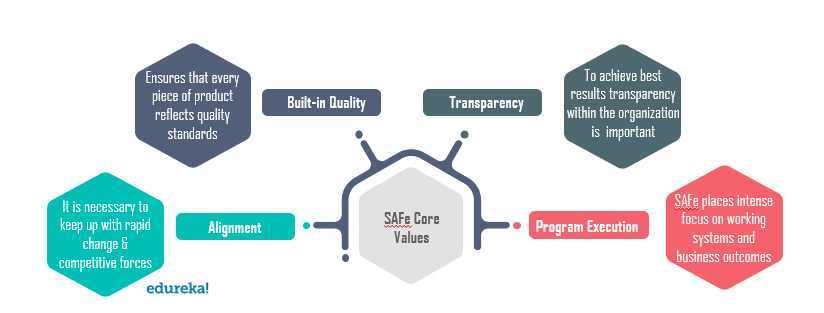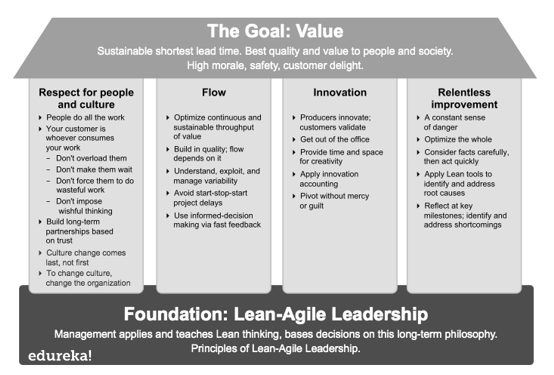PMP Certification Training
- 88k Enrolled Learners
- Weekend/Weekday
- Live Class
Scaled Agile Framework or SAFe empowers complex organisations to achieve the advantages of Lean-Agile software and systems development at scale.
By implementing an Agile Framework, you avail the following benefits;
The detailed framework shows all of the key roles, Activities, deliverable, and flows. It also navigates the rest of the site.
The image given explains how agile process works. Epics are a huge body of work, further broken down into a number of smaller stories or sub-epics. These sub-epics are allocated to the team as a story. Each team then works on these stories or software features.
Scaled Agile Framework or SAFe was first developed by Dean Leffingwell’s books and blogs. Version 1.0 is the first officially released in 2011. The latest version which is 4.6, was released in October 2018. It is meant to provide guidance to work at enterprise Portfolio, Value Stream, Program, and Team levels.
SAFe, is a freely available online knowledge base that allows you to exercise lean-agile practices at an enterprise level. It gives you a simple, lightweight experience for the software development team. The whole framework is divided into 3 basic segments the Team, the Program and the Portfolio.
So, following are the features of SAFe;
Now, you might wonder when exactly should you use SAFe. So, here are a few instances when you could.
Another thing to ponder upon is that how is SAFe different from other agile practices,
Scaled Agile Framework stands upon the following base values;
Following are the basic principles and values for SAFe. They must be understood, exhibited and continued in order to get the best results upon execution of the framework.
SAFe is based on the following 4 core values.

Before teachers, Lean-Agile leaders are continuous learners. It helps them help their teams to build better systems through understanding and exhibiting the Lean-Agile SAFe Principles.
As an enabler, the ultimate responsibility of a leader is adoption, success and ongoing improvement of Lean-Agile developments. For the change and continuous improvement, leaders go through rigorous and continuous training.
Leaders truly empower and engage individuals and teams to achieve their highest potential.
The Lean-Agile mindset can be derived from the following two things.
Scaled Agile Framework(SAFe) is derived from the principles and practices inspired by the house of lean Toyota. Based on that, SAFe presents the SAFe House of Lean.
The goal is to deliver maximum customer value in the shortest lead time maintaining the highest possible quality delivered to the customer.
 Newer, better ways of developing software are being uncovered by the day by practising Agile and helping others do the same. That’s why, while there is immense value in the items on the right, we value the items held to the left even more.
Newer, better ways of developing software are being uncovered by the day by practising Agile and helping others do the same. That’s why, while there is immense value in the items on the right, we value the items held to the left even more.
Different Levels in SAFE
As per the latest version of SAFe, there are four levels of its implementation.
 Team Level SAFe
Team Level SAFeThe Team Level SAFe contains roles, events, and processes. Agile Teams build these roles, events and processes and deliver value in the context of the Agile Release Train (ART). It is mostly like a regular scrum team. Teams form the base of SAFe and the Lean enterprise, as they perform the clear majority of the work that delivers customer value.
Team Level SAFe creates high-performing teams that in turn, build high-quality components and solutions, supporting both team and technical agility. This is the primary construct of the program level.
Program Level SAFe has the roles and activities needed to continuously deliver solutions via an Agile Release Train (ART). This level is where development teams, stakeholders, and other resources are devoted to some important, ongoing system development mission.
The ART metaphor describes the program level teams, roles, and activities that incrementally deliver a continuous flow of value. ARTs are virtual organisations formed to span functional boundaries, eliminate unnecessary handoffs and steps, and accelerate value delivery by implementing SAFe Lean-Agile principles and practices.
Ultimately, the ARTs operating at the Program Level are responsible for creating and releasing value inflow at the frequency needed by the enterprise to meet market and customer demand. These mindsets and practices in this level contribute to the enterprise competency of DevOps and Release on Demand that makes this flow of value possible.
The Value Stream Level is optional in SAFe. It is a new addition in SAFe 4.0. It is designed for larger, independent enterprises which have complex solutions. It is intended to aid cyber-physical systems for software, hardware, electrical and electronics, optics, mechanics, fluidics, etc.
It supports cadence and synchronization for multiple ARTs and Suppliers and gives additional roles such as Value Stream Engineer, Solution Architect/Engineering, and Solution Management.
This is the highest level of interest/ concern /involvement/ in SAFe. The portfolio level SAFe provides the basic blocks for organizing the Lean-Agile Enterprise flow of value via one or more Value Streams. It helps to develop systems and solutions which are described in strategic themes.
To meet strategic objectives, portfolio level encapsulates certain elements by basic budgeting and other governance mechanisms. Hence, it assures that the investment in the value streams provides the returns necessary for the enterprise.
A portfolio is connected bi-directionally to business;
Important key concepts used here are:
Scaled Agile Framework (SAFe) is an incremental improvement to the a-Framework that provides guidance on the five core competencies that help an organisation become a Lean-Agile. It has 4 levels and 4 configurations and is based purely on the Agile Manifesto and the SAFe House of Lean.
 Thank you for registering Join Edureka Meetup community for 100+ Free Webinars each month JOIN MEETUP GROUP
Thank you for registering Join Edureka Meetup community for 100+ Free Webinars each month JOIN MEETUP GROUPedureka.co